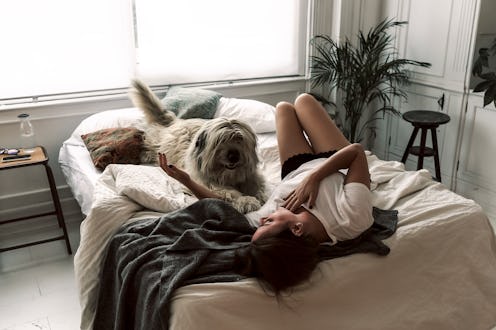Wellness
Can't Sleep? TikTok Says This Weird Sleep Position Works Like A Charm
“Changing something about your usual setup can trick your brain.”

As the saying goes, desperate times call for desperate measures. If you’ve been in bed for hours but can’t seem to nod off you might get to the point where you’re willing to try anything to fall asleep, from reverse psychology and meditation apps to making a cocoon or a sleep-inducing mocktail. When you’re really desperate to snooze you may even decide to flip upside down. Though it might sound like the strangest option of them all, TikTok says it really does work.
Instead of resting with your head on your pillow and your feet at the end of your bed like you normally would, the idea is to sleep in the other direction so your head is where your feet typically go. The goal is to change your POV and get into a new position, and it seems to work wonders when it comes to falling asleep.
According to Jessica Fink, LCSW, PLLC, a psychotherapist who specializes in insomnia, it isn’t surprising that many people find this trick helpful — and it’s also one you may have already tried on your own without realizing it’s common. “People with sleep struggles will try anything,” she tells Bustle, including maneuvering into odd sleep positions.
While there are many sleep hacks out there, the main draw with this one is that it’s easy. You don’t have to get out of bed, mix up a drink, or even think too hard — all good things when you’re already tired. Another is that it seems to be super effective. Here’s what to know about sleeping upside down and why it works.
Sleeping The Wrong Way In Bed
According to Dr. Shelby Harris, a licensed clinical psychologist and director of sleep health at Sleepopolis, there are several reasons why it can be tough to fall asleep at night.
“Stress and anxiety are big culprits — it’s hard to turn your brain off when it’s racing with thoughts or worries,” she tells Bustle. “Other common reasons include having an inconsistent sleep schedule or eating or drinking things like caffeine too late in the day. Even the basics, like being too hot, uncomfortable, or in a noisy room can make falling asleep feel impossible.”
If you’ve fixed all of these common issues and still can’t snooze, that’s when you might need to switch things up — quite literally. “While [this hack isn’t] backed by specific studies, some people say it works wonders,” Harris says. “It’s likely because changing something about your usual setup can trick your brain or break patterns that keep you awake.” In other words? Lying the wrong way in bed can feel new enough that it snaps you out of a thought spiral.
“Sleep does not reward effort and the harder you try, the more elusive it is.”
According to Fink, your brain can start to associate your bed with stress and being wide awake, especially if you have insomnia. By lying the other way you switch up your environment just enough to break this cycle. The novelty is what makes it easier to nod off.
“People with insomnia often find they sleep better in places other than their bed where there is less association with the stress of not sleeping,” she says. “Sleep does not reward effort and the harder you try, the more elusive it is. If flipping over is a way to stop trying to sleep, it could be effective.”
The other end of the bed might also feel more comfortable, cooler, or more refreshing. “[That] can help your body relax and settle into sleep mode,” says Harris.
How To Give It A Try
This sleep hack works best when you keep it casual and easy, so you don’t wake yourself up even more or defeat the purpose of this relaxing change of scenery by making a fuss about getting up, yanking covers, or remaking your bed.
The next time you can’t sleep, simply grab your pillow, flip the other way, and plop down with your head where your feet normally go. Many people say they fall asleep right away.
“If you’re still awake after about 20 minutes, that’s a good time to try something new — whether it’s flipping your sleep position [again] or getting out of bed for a little while,” says Harris. “The key is not to lie there frustrated for too long, which can make it harder to fall asleep.”
Instead, she recommends getting up and doing something relaxing — like reading — until you feel genuinely drowsy, and that’s when you can climb back into bed to give it another go.
Sources:
Jessica Fink, LCSW, PLLC, psychotherapist
Dr. Shelby Harris, licensed clinical psychologist, director of sleep health at Sleepopolis